[FONT=Arial, sans-serif]Context: trying to make a [/FONT][FONT=Arial, sans-serif]3[/FONT][FONT=Arial, sans-serif]-way horn on a budget. To learn more about horns, not to make the “best” speakers ever. I am aware of the compromise i am taking which this approach. More bandwidth from the midbasshorn is what i am after just to make crossover to the mid easier. I know exta bandwidth and high spl is a contradiction. [/FONT]
[FONT=Arial, sans-serif]I have been reading up on backloaded horns. And have found several methods of handling the delayed backwave coming out of the horn. Some questions arise, there seems to be no general agreement on how to handle the backwave. It would be nice if we somehow could end up with a rough guideline for handling the backwave in a backloaded horn in this thread. [/FONT]
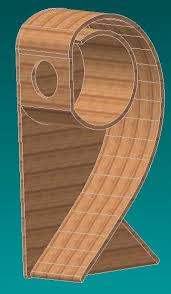
[FONT=Arial, sans-serif]
[/FONT][FONT=Arial, sans-serif]Method one. Replikon horn / Horn reflex
– the delay of the backwave is a problem, backwave pathlength should be under 1.4 meter[/FONT]
– [FONT=Arial, sans-serif]the bends in the horn should be as smooth as possible
– the crossover between horn output and woofer should be as low as possible.
– the backchamber should be big, to create a lowpass for the backwave.
– high Qes woofer, massloading close to a ported design. [/FONT]
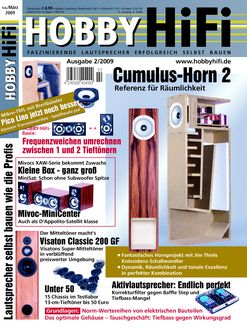
[FONT=Arial, sans-serif]Method two. Cumulus 2 Hobby Hifi, Fostex etc.
– the delay of the backwave is not a big problem. (lenght above 2 meters)
– the bends in the horn act a lowpass and should be “boxy” to cutoff the backwave. Difraction in the horn is welcome and positive. See the Fostex reflectors.
– the crossover between horn and woofer output matches the need for bafflestep
– there should be no backchamber.
– 2 x Fs/ Qes (25 Hz & 0.15 Qes) = 344 Hz massloading point where the backwave should begin to fallofff.[/FONT][FONT=Arial, sans-serif] [/FONT][FONT=Arial, sans-serif](Cumulus 2 horn, Thiel coincident).
[/FONT][FONT=Arial, sans-serif]
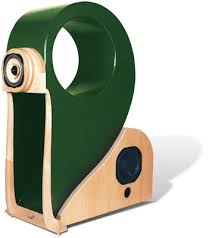
[/FONT][FONT=Arial, sans-serif]Method three. Carfrae/ Hedlund
– the delay of the backwave is no problem. (lenght around 2 meters)
– the bends in the horn should be as smooth as possible
– the crossover between hornoutput and woofer should be as high as possible
– there should be no backchamber or it should be really small (magnet depth)[/FONT]
– [FONT=Arial, sans-serif]2 x Fs/ Qes (45 Hz & 0.23 Qes) = 393 Hz (Lowther)
Here goes. There is probably a relation between the length of the hornpath and the amount of midrange hornoutput that is usable. Would it be possible to use 1/3 offset placement of the driver in a backloaded horn to shorten the pathlength (reduce phase differences). Set the driver back in regard to the hornmouth (imagine the driver in the right upper corner of below horn) and get more usable bandwidth? What would be the delaytime / hornlength that would work this high up in the 5 – 600 Hz range? I found numbers from 2 to 6 milliseconds. The Haas effect is our friend i asume, but how far up in the midrange can we push this?[/FONT][FONT=Arial, sans-serif]

[/FONT][FONT=Arial, sans-serif]What i have seen from measurements, even horns that use "difraction" to smooth out the peaks as above, have output high up into the 400 Hz region.
On a side note. I would appreciate some thought before using abbreviations. I found quite some older Diyaudio post unreadable due to the extensive use of VB, IB, WG and DT.[/FONT][FONT=Arial, sans-serif]
[/FONT]
[FONT=Arial, sans-serif]I have been reading up on backloaded horns. And have found several methods of handling the delayed backwave coming out of the horn. Some questions arise, there seems to be no general agreement on how to handle the backwave. It would be nice if we somehow could end up with a rough guideline for handling the backwave in a backloaded horn in this thread. [/FONT]
[FONT=Arial, sans-serif]
[/FONT][FONT=Arial, sans-serif]Method one. Replikon horn / Horn reflex
– the delay of the backwave is a problem, backwave pathlength should be under 1.4 meter[/FONT]
– [FONT=Arial, sans-serif]the bends in the horn should be as smooth as possible
– the crossover between horn output and woofer should be as low as possible.
– the backchamber should be big, to create a lowpass for the backwave.
– high Qes woofer, massloading close to a ported design. [/FONT]

[FONT=Arial, sans-serif]Method two. Cumulus 2 Hobby Hifi, Fostex etc.
– the delay of the backwave is not a big problem. (lenght above 2 meters)
– the bends in the horn act a lowpass and should be “boxy” to cutoff the backwave. Difraction in the horn is welcome and positive. See the Fostex reflectors.
– the crossover between horn and woofer output matches the need for bafflestep
– there should be no backchamber.
– 2 x Fs/ Qes (25 Hz & 0.15 Qes) = 344 Hz massloading point where the backwave should begin to fallofff.[/FONT][FONT=Arial, sans-serif] [/FONT][FONT=Arial, sans-serif](Cumulus 2 horn, Thiel coincident).
[/FONT][FONT=Arial, sans-serif]
[/FONT][FONT=Arial, sans-serif]Method three. Carfrae/ Hedlund
– the delay of the backwave is no problem. (lenght around 2 meters)
– the bends in the horn should be as smooth as possible
– the crossover between hornoutput and woofer should be as high as possible
– there should be no backchamber or it should be really small (magnet depth)[/FONT]
– [FONT=Arial, sans-serif]2 x Fs/ Qes (45 Hz & 0.23 Qes) = 393 Hz (Lowther)
Here goes. There is probably a relation between the length of the hornpath and the amount of midrange hornoutput that is usable. Would it be possible to use 1/3 offset placement of the driver in a backloaded horn to shorten the pathlength (reduce phase differences). Set the driver back in regard to the hornmouth (imagine the driver in the right upper corner of below horn) and get more usable bandwidth? What would be the delaytime / hornlength that would work this high up in the 5 – 600 Hz range? I found numbers from 2 to 6 milliseconds. The Haas effect is our friend i asume, but how far up in the midrange can we push this?[/FONT][FONT=Arial, sans-serif]

[/FONT][FONT=Arial, sans-serif]What i have seen from measurements, even horns that use "difraction" to smooth out the peaks as above, have output high up into the 400 Hz region.
On a side note. I would appreciate some thought before using abbreviations. I found quite some older Diyaudio post unreadable due to the extensive use of VB, IB, WG and DT.[/FONT][FONT=Arial, sans-serif]
[/FONT]
Last edited:
[FONT=Arial, sans-serif]These picture will probably better descibe my delusion  Both horns use the same Fostex FW208N driver; Re 5.8 Ohm, Fs 31 Hz, Qes 0.26, Vas 12 liter, Sd 204 cm2, Le 0.51 mH, Xmax 6.5mm. [/FONT]
Both horns use the same Fostex FW208N driver; Re 5.8 Ohm, Fs 31 Hz, Qes 0.26, Vas 12 liter, Sd 204 cm2, Le 0.51 mH, Xmax 6.5mm. [/FONT]
[FONT=Arial, sans-serif]
Blackline; classic Fostex BK201 horn
Hornlenght 1.70 meter, Vb (compression chamber) 7.3 liter, exponential, throath 155 cm2, mouth 750cm2
Redline; back loaded horn with driver placement offset.
Hornlength 2.50 [FONT=Arial, sans-serif]meter, driver offset 0.865 meter from start of horn, Hyperbolical flare. No compression chamber, throat 70cm2, mouth 750cm2. Driver offset from end of horn -0.31 cm. [/FONT][/FONT]
[FONT=Arial, sans-serif]Let's pretend we can we shorten the “redline” horn to below 2 meters and thereby shorten the pathlenght in the horn. Making it more usable in the midrange...? Less delay...? Use a lower Qes driver etc?
[FONT=Arial, sans-serif]
Left fostex BK201 horn, right offset driver horn.
[/FONT]
An externally hosted image should be here but it was not working when we last tested it.
[FONT=Arial, sans-serif]
Blackline; classic Fostex BK201 horn
Hornlenght 1.70 meter, Vb (compression chamber) 7.3 liter, exponential, throath 155 cm2, mouth 750cm2
Redline; back loaded horn with driver placement offset.
Hornlength 2.50 [FONT=Arial, sans-serif]meter, driver offset 0.865 meter from start of horn, Hyperbolical flare. No compression chamber, throat 70cm2, mouth 750cm2. Driver offset from end of horn -0.31 cm. [/FONT][/FONT]
[FONT=Arial, sans-serif]Let's pretend we can we shorten the “redline” horn to below 2 meters and thereby shorten the pathlenght in the horn. Making it more usable in the midrange...? Less delay...? Use a lower Qes driver etc?
An externally hosted image should be here but it was not working when we last tested it.
[/FONT][FONT=Arial, sans-serif]
Left fostex BK201 horn, right offset driver horn.
[/FONT]
Last edited:
Thanks, I am a NOOB at horns, not speakers in general 
The hornopening to the back preference is interesting. Could be extra delay, could be damping of "garbage" peaks... Oh i forgot, the speaker placement on top with the basket up is only ok upto a certain diameter driver. The Fostex 208N would still be 180 degrees directive at +- 800 Hz.
There's an old thread at the Audio Asylum about backloaded horn delay. High efficiency speaker asylum. Re: How do we hear (if we hear) a lag of 0.016 sec at low frequencies?
The hornopening to the back preference is interesting. Could be extra delay, could be damping of "garbage" peaks... Oh i forgot, the speaker placement on top with the basket up is only ok upto a certain diameter driver. The Fostex 208N would still be 180 degrees directive at +- 800 Hz.
There's an old thread at the Audio Asylum about backloaded horn delay. High efficiency speaker asylum. Re: How do we hear (if we hear) a lag of 0.016 sec at low frequencies?
Last edited:
Mass rolloff really does not work. I used a bass driver in a short horn similar to the Klipsch La Scala. According to Fr and Q it should roll off above 180 Hz or so, in practise it was quite flat up to 1200 Hz!
In the Jericho 08 horn they calculate that bass horn should fill in below the baffle step of the driver. Then there is the trade off between deep bass/long horns and time delays. The idea is to match the lowpass of the horn with the frontradiation aided by the baffle step coming in.
In the Jericho 08 horn they calculate that bass horn should fill in below the baffle step of the driver. Then there is the trade off between deep bass/long horns and time delays. The idea is to match the lowpass of the horn with the frontradiation aided by the baffle step coming in.
Thanks, i toyed around with the edge to place the FW208N asymetrical on a 55 x 45 cm wide (top) baffle. I am curious about "shooting" far over the horn output meets driver output point, with a low Qes speaker. But need some more input, don't like to waste expensive Birch plywood.
Last edited:
frugal-horn
Try search herein Diyadio for Frugal-horn or Planet 10's site. F-H looks easy to construct and the drivers will not break the bank. ...regards, Michael
Could someone point me out to a horndesign with a smooth backhorn and a very low Qes driver? Still curious about what amount of mid is coming out of the horn
Try search herein Diyadio for Frugal-horn or Planet 10's site. F-H looks easy to construct and the drivers will not break the bank. ...regards, Michael
[FONT=Arial, sans-serif]Context: trying to make a [/FONT][FONT=Arial, sans-serif]3[/FONT][FONT=Arial, sans-serif]-way horn on a budget. To learn more about horns, not to make the “best” speakers ever. I am aware of the compromise i am taking which this approach. More bandwidth from the midbasshorn is what i am after just to make crossover to the mid easier. I know exta bandwidth and high spl is a contradiction. [/FONT]
[FONT=Arial, sans-serif]I have been reading up on backloaded horns. And have found several methods of handling the delayed backwave coming out of the horn. Some questions arise, there seems to be no general agreement on how to handle the backwave. It would be nice if we somehow could end up with a rough guideline for handling the backwave in a backloaded horn in this thread. [/FONT]

[FONT=Arial, sans-serif]
[/FONT][FONT=Arial, sans-serif]Method one. Replikon horn / Horn reflex
– the delay of the backwave is a problem, backwave pathlength should be under 1.4 meter[/FONT]
– [FONT=Arial, sans-serif]the bends in the horn should be as smooth as possible
– the crossover between horn output and woofer should be as low as possible.
– the backchamber should be big, to create a lowpass for the backwave.
– high Qes woofer, massloading close to a ported design. [/FONT]

[FONT=Arial, sans-serif]Method two. Cumulus 2 Hobby Hifi, Fostex etc.
– the delay of the backwave is not a big problem. (lenght above 2 meters)
– the bends in the horn act a lowpass and should be “boxy” to cutoff the backwave. Difraction in the horn is welcome and positive. See the Fostex reflectors.
– the crossover between horn and woofer output matches the need for bafflestep
– there should be no backchamber.
– 2 x Fs/ Qes (25 Hz & 0.15 Qes) = 344 Hz massloading point where the backwave should begin to fallofff.[/FONT][FONT=Arial, sans-serif] [/FONT][FONT=Arial, sans-serif](Cumulus 2 horn, Thiel coincident).
[/FONT][FONT=Arial, sans-serif]

[/FONT][FONT=Arial, sans-serif]Method three. Carfrae/ Hedlund
– the delay of the backwave is no problem. (lenght around 2 meters)
– the bends in the horn should be as smooth as possible
– the crossover between hornoutput and woofer should be as high as possible
– there should be no backchamber or it should be really small (magnet depth)[/FONT]
– [FONT=Arial, sans-serif]2 x Fs/ Qes (45 Hz & 0.23 Qes) = 393 Hz (Lowther)
Here goes. There is probably a relation between the length of the hornpath and the amount of midrange hornoutput that is usable. Would it be possible to use 1/3 offset placement of the driver in a backloaded horn to shorten the pathlength (reduce phase differences). Set the driver back in regard to the hornmouth (imagine the driver in the right upper corner of below horn) and get more usable bandwidth? What would be the delaytime / hornlength that would work this high up in the 5 – 600 Hz range? I found numbers from 2 to 6 milliseconds. The Haas effect is our friend i asume, but how far up in the midrange can we push this?[/FONT][FONT=Arial, sans-serif]

[/FONT][FONT=Arial, sans-serif]What i have seen from measurements, even horns that use "difraction" to smooth out the peaks as above, have output high up into the 400 Hz region.
On a side note. I would appreciate some thought before using abbreviations. I found quite some older Diyaudio post unreadable due to the extensive use of VB, IB, WG and DT.[/FONT][FONT=Arial, sans-serif]
[/FONT]
None of those are really 'horns' tho are they? Top is more a BVR the second is an offset TL. Slightly pedantic but I was under the impression true horns were defined by pretty specific maths.
I am not that interested in the true definition of horns. I am interested in how the backwave is handled. There is probably a better academic for backwave... A study showing a horn with a low Qes driver with a smooth path compared directly with a rough path would be welcome. A link where this is done in transmissionlines would be welcome to. I am interested in the crossover point from backwave to driver, in what i would call a backloaded horn.
Some questions about Hornresp
-how does hornresp handle mass rolloff Fs x 2/ Qes?
-would it be possible to move the hornmouth up or down in regard to the driver? Driver on the back of cabinet, distance to mouth x,y,z
Some questions about Hornresp
-how does hornresp handle mass rolloff Fs x 2/ Qes?
-would it be possible to move the hornmouth up or down in regard to the driver? Driver on the back of cabinet, distance to mouth x,y,z
Last edited:
Thanks,
I have a fine >90 dB fullrange speaker at home. Would like to step it up to >100 dB, the Frugal horn looks are stunning.
If you can do it, well ...

But at what price ( in the remote case that the thing is achievable) ?
You'll still have two ( not counting the walls of the enclosure ) distinct sound sources, conflicting.
As I see you have Ajhorn ( I don't), I found very interesting the introduction.
Thanks Pico,
I am familiar with single fullrange speakers. And what they can do in Back Loaded Horns. From a recent link in a HM art thread i found these numbers for the summation effect. Two sources need to be under 1.5 ms from each other to sum correctly. There is little information (links welcome!) about this effect in regards to Spl and frequency.
It would be nice if we had a curve like this for hearing delay in regards with spl and Hz. The maximum length of a horn and where the high cut off (mass roll off, volume of chamber, etc) needs to be would imho follow from such a curve.
I am familiar with single fullrange speakers. And what they can do in Back Loaded Horns. From a recent link in a HM art thread i found these numbers for the summation effect. Two sources need to be under 1.5 ms from each other to sum correctly. There is little information (links welcome!) about this effect in regards to Spl and frequency.
An externally hosted image should be here but it was not working when we last tested it.
It would be nice if we had a curve like this for hearing delay in regards with spl and Hz. The maximum length of a horn and where the high cut off (mass roll off, volume of chamber, etc) needs to be would imho follow from such a curve.
Last edited:
Different SPL- different velocity inside the "box". Sounds like there is only one optimal
level to be played for the typical horn enclosure, doesn't it ? Like T/S parameters that are found at very little levels...then compression arises as a magnet gets hotter.
So you'll still have to deal with driver's diameter when considering a fullrange driver: bigger bass but no highs or good dispersion with sacrificed SPL.
HAve you considered the low-pass properties of the bends ?
level to be played for the typical horn enclosure, doesn't it ? Like T/S parameters that are found at very little levels...then compression arises as a magnet gets hotter.
So you'll still have to deal with driver's diameter when considering a fullrange driver: bigger bass but no highs or good dispersion with sacrificed SPL.
HAve you considered the low-pass properties of the bends ?
Hi Pico,
The hornenclosure i am after is not for a fullrange driver. It's for a three way horn. 50-500 Hz, 500-3. kHz, 3 kHz ->. I just found this driver: Oberton 8M250 I hope to end up with this driver for the 1/3 backloaded horn experiment. I am interested in moving up a little bit in frequency with this driver 50-600 or 700Hz, hope to get there by shortening the path of the woofer to the hornmouth by offset placement in the horn / cabinet. So for this purpose i need to know more about usable frequency from the backwave of the horn. (and the effect of bends
The hornenclosure i am after is not for a fullrange driver. It's for a three way horn. 50-500 Hz, 500-3. kHz, 3 kHz ->. I just found this driver: Oberton 8M250 I hope to end up with this driver for the 1/3 backloaded horn experiment. I am interested in moving up a little bit in frequency with this driver 50-600 or 700Hz, hope to get there by shortening the path of the woofer to the hornmouth by offset placement in the horn / cabinet. So for this purpose i need to know more about usable frequency from the backwave of the horn. (and the effect of bends
Last edited:
I would trust the manufacturer.8M250 is intended for use as a direct radiating or horn loaded midrange speaker.
Wrong choice, try again !
And...you didn't specify for which usage you intend to put these drivers into..exercise. For in-home use a 50/100 W driver is ok.
So for home the making of the project includes the positioning, where you are placed, too, or wheter you move around...So the integration of direct radiation and what follows in propagation of the back wave is also dependent of near-fiel or far field listening position. I wouldn't trust too much that 1,5 ms time for distinguishing between the sources ( the mouth ...) which is real low but what happens if/when you put your attention to what really happens ?
Any "timing" would then result "good" if the speaker " sounds good" .
I am not that worried about the intended use of the 8M250 Oberton. Xmax is low with 1.0 mm that's for sure. But for example Xmax for the Fostex FE208 Sigma used in the Jericho horn is 0.75 mm. And that seems to work alright.
Intended use is at home with 8 to 10 watt tube amp. Listening distance 3.0 meters and up. +-35m2 room.
Intended use is at home with 8 to 10 watt tube amp. Listening distance 3.0 meters and up. +-35m2 room.
Oh yes, a fat coil to overcome the rising response and it 'll settle at 90-91 dB.


BTW I built something similar to the Jericho horn in 1997 ( a little late ! That project is from '96 ) with lateral mouth. Some drivers passed around ( replacing the dead ones )the first being Pioneer then Goldsound ( Similar to Pioneer's BOFU !?! ) which were 7" now it houses a Vifa 8". Now they're two ways with a 2" mid-tw in a BIG 8" waveguide ( made from a a dead speaker, guess...). Sort of mix between the jericho design and an expanding TL by putting some resistance at the terminus /mouth.
)the first being Pioneer then Goldsound ( Similar to Pioneer's BOFU !?! ) which were 7" now it houses a Vifa 8". Now they're two ways with a 2" mid-tw in a BIG 8" waveguide ( made from a a dead speaker, guess...). Sort of mix between the jericho design and an expanding TL by putting some resistance at the terminus /mouth.
But real bass is another thing, or it isn't ?
"Seems" it's not a valid term

BTW I built something similar to the Jericho horn in 1997 ( a little late ! That project is from '96 ) with lateral mouth. Some drivers passed around ( replacing the dead ones
But real bass is another thing, or it isn't ?
"Seems" it's not a valid term
Speaking of Jericho, this is an extremly interesting thread in the German spoken Visaton forum, about horns: Welche Daten muss ein Horntreiber haben? - Visaton Diskussionsforum
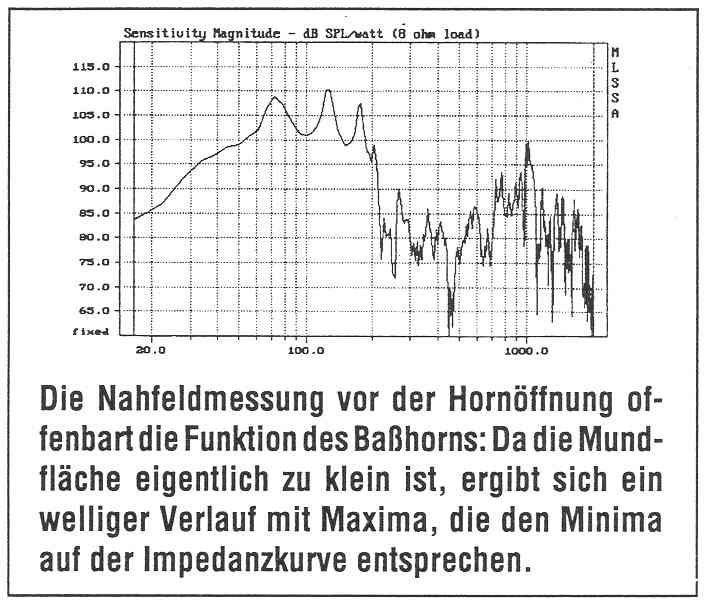
Nearfield measurement of the mouth of the Jericho horn.
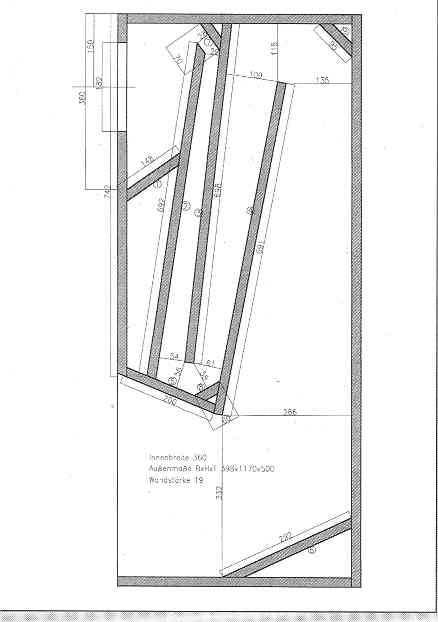
Seems the bandpass limiting effect of the small backchamber is not that great. -6dB at 1 kHz there is still an awful amount of noise coming out of the mouth. Pico, i just did a google search for lateral mouth (....) feel free to post a picture to show what you mean. Breaks down the language barrier!

Nearfield measurement of the mouth of the Jericho horn.

Seems the bandpass limiting effect of the small backchamber is not that great. -6dB at 1 kHz there is still an awful amount of noise coming out of the mouth. Pico, i just did a google search for lateral mouth (....) feel free to post a picture to show what you mean. Breaks down the language barrier!
Last edited:
- Status
- This old topic is closed. If you want to reopen this topic, contact a moderator using the "Report Post" button.
- Home
- Loudspeakers
- Multi-Way
- Backloaded horns, do we want delayed bass, and how do we want it?
